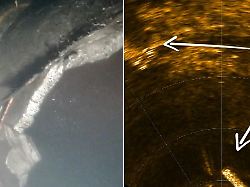Exclusive research
Nord Stream 2 exploded by small explosive charge
By Markus Frenzel
6/21/2023 6:04 am
An international media research with the participation of RTL shows that the damaged strand of the Nord Stream 2 Baltic Sea pipeline suffered only comparatively little damage. This indicates a small explosive device of a few kilograms.
An international team of journalists from RTL, the Danish television channel TV2, the Danish newspaper “Ekstra Bladet” and the French daily newspaper “Libération” received exclusive footage of the destroyed Nord Stream 2 pipeline. It can be seen that the Nord Stream 2 branch A explosion caused far less damage than the somewhat later Nord Stream 1 pipeline explosion, eighty kilometers to the north. So far, experts had assumed that significant amounts of explosives must have been responsible for the explosion in the pipelines.
A submersible drone from the Norwegian company Blueye submerged the explosion site off the coast of Bornholm and documented the destruction of the Nord Stream 2 pipeline. Accordingly, the tube is only interrupted at one point. The northern part rises about five meters above the seabed. The southern part is still almost unchanged on the bottom of the Baltic Sea.
Traces point to a shaped charge
An explosion due to several hundred kilograms of explosives can thus be virtually ruled out. “We should have found broken concrete, scratched metal, burn marks and burst pipes everywhere, which we don’t have,” says Danish intelligence expert Oliver Alexander, who accompanied the research. “It looks more like a precision blast here.”
Explosives experts, to whom the cooperating journalists showed the film footage, assume a so-called hollow charge, i.e. an explosive charge that is shaped in such a way that it bundles the effect of the explosive energy and therefore uses less explosive. “It clearly looks like a shaped charge to me,” says ex-Danish military officer Niels Kamp. “Huge forces were at work that were very focused. It was a small explosive device.” A former French mine diver, who wants to remain anonymous, is also committed: “It was certainly not a large explosive charge that was used, but rather a small one of a few kilograms,” he says. “From what I can see it looks very much like a shaped charge.” Such an explosive device can be installed much more easily at a depth of around 80 meters than several hundred kilograms of explosives. This would also make it more feasible for a smaller commando unit.
Recent reports pointed in the direction of Ukraine
The two Nord Stream pipelines were damaged by several explosions in the night of September 25th to 26th, 2022. At this point, Nord Stream 1 was no longer supplying gas to Germany; the pipeline had been shut down by the Russian side: after a maintenance break in the summer of 2022, Moscow imposed a delivery stop. Although Nord Stream 2 was already filled with gas, it never went into operation.
Both pipelines consist of two strands each. In Nord Stream 1, both pipelines were damaged, in Nord Stream 2 only line B. To this day, it is unclear who is responsible for the attacks. There are different, contradicting reports: According to the “Washington Post”, the US secret service CIA is said to have learned of an alleged plan by Ukraine for such an attack in June 2022. Ukrainian President Volodymyr Zelenskyy has denied his government’s involvement in the sabotage actions.
German investigators are said to have leads to Poland
According to a report by the Wall Street Journal, German investigators have indications that a suspected sabotage team may have used Poland as an operational base. The newspaper referred to the evaluation of data from the sailing yacht “Andromeda”, which according to earlier reports is said to have been used for the attacks. The Wall Street Journal article was denied by Poland.
In March, the “Andromeda” was presented by the ARD and the weekly newspaper “Die Zeit” as the ship from which a six-man commando carried out the attacks. According to this account, too, “tracks lead in the direction of Ukraine”.
“West has no interest in blaming Russia”
However, a visit by an RTL/ntv team to the “Andromeda” showed that there were some questions about the scenario of an attack from the sailing yacht. Danish military analyst Anders Puck Nielsen told ntv.de in March that he believed the most likely version was that Russia was responsible for the attacks. One motive could be “to demonstrate the vulnerability of Europe”. Referring to media reports of traces in the direction of Ukraine, Puck Nielsen said he assumes “that Western countries are not very interested in blaming Russia for the Nord Stream attacks at the moment.”
Investigative journalists from Nordic channels reported in May that before the explosions, several Russian naval ships were in the vicinity of the later site of the attack. Accordingly, the Russian ships stayed for hours and even a whole day in the areas where the explosions later occurred.
